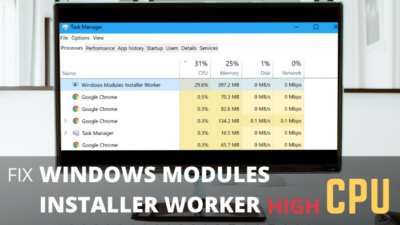It’s amazing how that tiny CPU handles all the tasks we threw at it. How does it handle heavy tasks like games, renderings, and other stuff at the same time?
It appears to be witchcraft, and on top of that the evolution of the CPU over the last decade is mind-boggling. And I’m always interested in talking about CPUs.
So, let’s get into the article, and I’ll tell you how many instructions this tiny brick can process at once.
How Does CPU Work?
The Central Processing Unit, or CPU, is the chip found in your device. Which is also your system’s brain. Your CPU’s function is to process data. The CPU handles all of your decision-making, calculating, and searching.
A CPU executes specific instructions by retrieving them from memory, also known as RAM. The operation is then decided by its Arithmetic Logic Unit (ALU). And then complete the process by carrying out the operation. It also stores the outcome in its memory. During the execution process, the CPU works extremely tight with the RAM.
CPU cache and registers play crucial roles in storing and fetching instructions. Though they are not the same.
The CPU is also in charge of your system’s hardware. It supervises the Hard disk, Sound system, Graphics system, input/output devices, and other hardware.
A CPU is made up of six major components. The control unit (CU), register, arithmetic logic unit (ALU), cache, buses, and clock are the components. Besides that, most CPUs are made of silicon and contain thousands upon thousands of transistors that act as switches.
Overall, the Central Processing Unit executes all of your commands. So, how many instructions can a CPU handle at once? Let’s get started with the topic in the section below.
How Many Instructions Can a CPU Process at a Time
It appears that a CPU can effortlessly perform many commands. You can complete your personal task while listening to music and reading and responding to messages. As a result, you may believe that the Central processing unit executes all tasks concurrently.
A processor, on the other hand, can only carry out one instruction at a time. But, the CPU carries out these instructions so fast that it appears like the processor performs all the instructions at once.
FYI processor and CPU are the same, so don’t get confused when I refer to one over another.
If you are a competitive gamer, you’ve heard the term Clock Speed — the rate at which a CPU can execute instructions. Every tick of the clock indicates that the processor has completed one command.
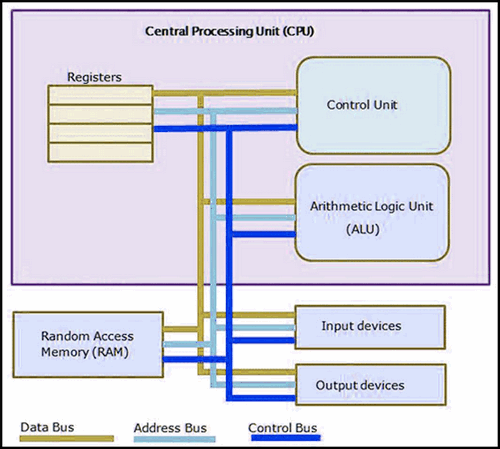
Besides that, this method’s measuring technique is cycles per second. And one cycle per second is related to 1 Hertz. So, if a CPU’s clock speed is 3 gigahertz (GHz), it can perform three thousand million or three billion cycles per second.
| Cycles per second | Rate |
|---|---|
| 1 | 1 Hertz |
| 1 million | 1 Megahertz (MHz) |
| 1,000,000,000 | 1 Gigahertz (GHz) |
IPC is different terminology for how effectively a CPU can execute commands. IPC, or instructions per cycle/clock, is an acronym. IPC measures how many jobs a CPU can finish in one cycle, whereas clock speed measures how many cycles a processor can execute in a second.
To put it another way, a processor with a faster clock speed can perform more cycles in a single second. And a CPU with more IPC but a lower clock speed can still outperform a CPU with a higher clock speed. Because when the CPU’s IPC is efficient, it can perform the task more precisely.
The best way to make a faster CPU is to carefully balance clock speed, core count, and IPC. IPC can be defined as how consistently a cycle can be completed or how much it can accomplish in a single cycle. IPC is one of the crucial measuring terms to acknowledge the performance of the processor.
In modern times, every processor has multiple cores. There are two, four, eight, or even more cores in the single processor. A CPU which have 2 cores is called a Dual-Core and the machine considers it as two processors.
That being said, a dual-core processor can perform two instructions at the same time compared to a single-core processor, for example. And, more cores can execute more instructions at the same time.
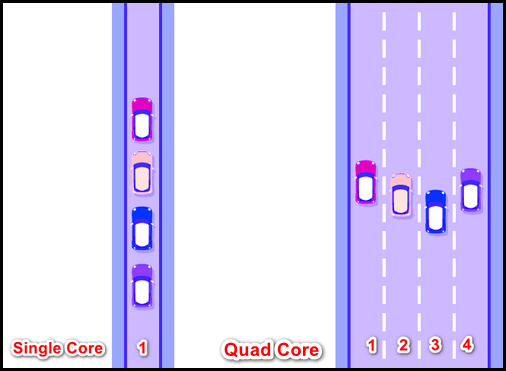
All things considered, a processor can only perform one instruction at a time. But even so, a second CPU can perform 3 or 4 billion instructions. That is why it appears that the processor is performing all tasks at once. Also, when the number of cores increases, the performance just multiplies.
How CPU Process Instructions
A modern CPU is capable of executing billions of instructions per second. However, there is still a ticking clock at the heart of your machine or PC that performs the fetch-execute cycle.
Furthermore, the clock speed or frequency is also expressed as gigahertz. It literally is a measure of how quickly the transistor is in a processor switch.
CPU accomplishes the instructions in three steps — Fetch, Decode, and finally Execute. The process also points out as a fetch-execute cycle.
During the Fetch cycle, information and instructions are transferred from RAM to the CPU. The control module converts the commands as signals in the following phase of the cycle that is decoded. Then it passes it on to the other part for execution.
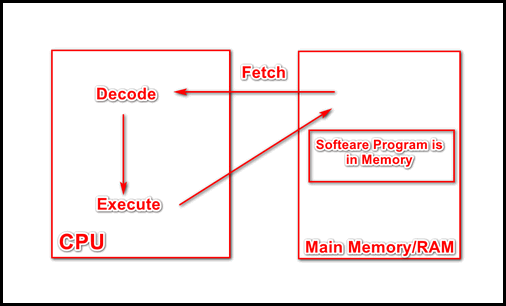
The cycle is Fetch the instructions one at a time from memory/RAM to CPU → decode the instruction → execute the instructions. And, this cycle repeats continuously.
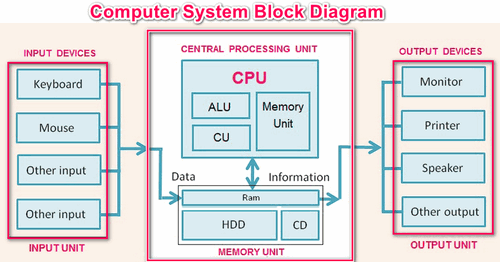
This is the total process for a CPU to complete the cycle. And it runs in the background constantly to cover all the functions you assign to your machine.
FAQs
Can a CPU do multiple tasks at once?
Yes. A single-core CPU (processor) can run two or more threads at the same time. These threads could be from the same program or from various programs and therefore processes. Simultaneous MultiThreading is the name given to this sort of Multi-Threading (SMT).
What is the maximum amount of data a CPU can process at once?
The size of the internal information bus, registers, and ALU, among some other factors, determine word length. An 8-bit CPU could indeed process 8 bits of information at a time. The word length can range from 4 to 64 bits, depending on the kind of microcomputer.
How does a CPU process so many instructions?
The arithmetic-logic unit, or ALU, is a combinational logic unit inside the CPU’s processor that performs the real arithmetic and logical operations for each instruction. Overall, a Processor performs directions by retrieving them from memory, performing an operation with its ALU, and afterward storing this same result in memory.
Does the CPU process all data?
The CPU is a computer’s brain, containing all the circuitry required to process information, and store the data, and expected outputs. The CPU is constantly following computer program instructions that inform which information to function and how it should process it. We couldn’t run a computer’s programs without a CPU.
Final Thoughts
A CPU can only handle one task at a time. However, the clock speed is so intense that it appears to perform multiple tasks at once.
In addition, a modern CPU has 4–8 cores in a typical system. When there are more cores, the system refers to them as different CPUs. As a result, task management capability goes through the roof.
All things considered, a CPU is the heart of a Computer system. It can also complete billions of tasks in seconds.

